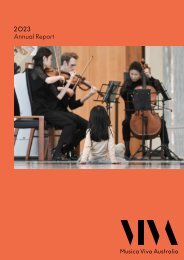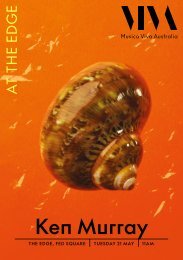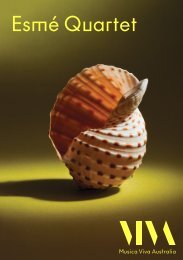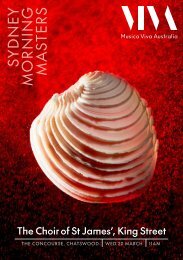Australian String Quartet & Konstantin Shamray Program Guide | March 2022
Create successful ePaper yourself
Turn your PDF publications into a flip-book with our unique Google optimized e-Paper software.
At the outset of his engagement with<br />
the ‘Razumovsky’ quartets, Beethoven<br />
enthusiastically wrote to his publisher<br />
Breitkopf: ‘I am thinking of devoting myself<br />
almost entirely to this type of composition’.<br />
But by the end of 1806 he had clearly<br />
changed his mind: he was working on<br />
the Fourth Piano Concerto, the Fourth<br />
Symphony and the Violin Concerto. It<br />
would be too much to say that he had<br />
lost interest in the quartet medium; still,<br />
this C major quartet, the last of the three,<br />
does appear to have been written a<br />
great deal more quickly than the others,<br />
and is probably the least substantial of<br />
them (though ‘least substantial’, in this<br />
context, is a very relative term). Certainly<br />
the emotional world, and indeed the<br />
musical structure, of the quartet is more<br />
conventional than that of its fellows;<br />
perhaps that is why it was the only one<br />
to enjoy a certain measure of immediate<br />
success with the public.<br />
The mysterious slow introduction is rather<br />
reminiscent of the start of Mozart’s famous<br />
‘Dissonance’ <strong>Quartet</strong> (also in C major).<br />
The first violin and the cello slowly fan out<br />
to the top and bottom of their respective<br />
registers, scrupulously avoiding any trace<br />
of C major, and when a cadenza-like<br />
flourish for the first violin gets the Allegro<br />
under way, it still takes a few bars for<br />
the main key to be fully established. The<br />
development section begins with the initial<br />
violin figure wandering through further<br />
keys and ends with a florid variation of<br />
it; the rest of the movement proceeds in<br />
a more or less orthodox way, but has a<br />
surprise ending in store.<br />
Unlike its predecessors in Op. 59, the C<br />
major quartet does not quote an actual<br />
Russian theme [in homage to Count<br />
Razumovsky, who commissioned them]<br />
but the slow movement is clearly intended<br />
as a piece in the Slavic manner. Or at least,<br />
that is the character of the first theme,<br />
which pervades the whole movement; the<br />
second theme, in C major, is altogether<br />
more at home in Beethoven’s Vienna. The<br />
Andante is a huge, sombre structure, lying<br />
somewhere between ternary and sonata<br />
form, but not satisfactorily accounted for<br />
by either. Since the finale is going to be a<br />
brilliant Allegro molto, there is no particular<br />
point in having a rapid scherzo as the third<br />
movement. Instead, somewhat unusually<br />
for his middle period, Beethoven writes a<br />
minuet which seems to be an invocation of<br />
a graceful bygone era, though it has a trio<br />
section which is somewhat more robust.<br />
After the minuet has returned, a coda<br />
leads to the finale which is a high-powered<br />
combination of fugue and sonata; not one<br />
of Beethoven’s most searching finales,<br />
perhaps, but certainly one of the most<br />
brilliant.<br />
© RICHARD TOOP<br />
|<br />
7<br />
|


















